Acoustic Mapping of Submerged Stone Age Sites—A HALD Approach
Abstract
1. Introduction
2. Materials and Methods
2.1. Laboratory Testing and Finite Element Modelling
2.2. Field Testing
3. Results of the Applications of the HALD Method to the Investigation of Submerged Stone Age Sites
3.1. Atlit Yam, Carmel Coast, Israel
3.2. Møllegabet, Ærø, Denmark
3.3. Florida, United States of America
3.4. Roskilde Fjord, Denmark
3.5. Meilen Schellen in Lake Zürich, Switzerland
4. Discussion
5. Conclusions
Author Contributions
Funding
Institutional Review Board Statement
Informed Consent Statement
Data Availability Statement
Acknowledgments
Conflicts of Interest
References
- Benjamin, J.; Rovere, A.; Fontana, A.; Furlani, S.; Vacchi, M.; Inglis, R.H.; Galili, E.; Antonioli, F.; Sivan, D.; Miko, S.; et al. Late Quaternary sea-level changes and early human societies in the central and eastern Mediterranean Basin: An interdisciplinary review. Quat. Int. 2017, 449, 29–57. [Google Scholar] [CrossRef]
- Brenna, J.T.; Carlson, S.E. Docosahexaenoic acid and human brain development: Evidence that a dietary supply is needed for optimal development. J. Hum. Evol. 2014, 77, 99–106. [Google Scholar] [CrossRef] [PubMed]
- Cortés-Sánchez, M.; Morales-Muñiz, A.; Simón-Vallejo, M.D.; Lozano-Francisco, M.C.; Vera-Peláez, J.L.; Finlayson, C.; Rodriguez-Vidal, J.; Delgado-Huertas, A.; Jiménez-Espejo, F.J.; Martínez-Ruiz, F.; et al. Earliest Known Use of Marine Resources by Neanderthals. PLoS ONE 2011, 6, e24026. Available online: https://journals.plos.org/plosone/article?id=10.1371/journal.pone.0024026 (accessed on 17 November 2020). [CrossRef] [PubMed]
- Crawford, M. Long-chain polyunsaturated fatty acids in human evolution. In Human Brain Evolution; Cunnane, S.C., Stewart, K.M., Eds.; Wiley and Sons: Hoboken, NJ, USA, 2010; pp. 13–31. [Google Scholar]
- Erlandson, J.M.; Braje, T.J. Coasting out of Africa: The potential of mangrove forests and marine habitats to facilitate human coastal expansion via the Southern Dispersal Route. Quat. Int. 2015, 382, 31–41. [Google Scholar] [CrossRef]
- Fischer, A.; Clemmesen, L.B.; Donahue, R.; Heinemeier, J.; Lykke-Andersen, H.; Lysdahl, P.; Mortensen, M.F.; Olsen, J.; Petersen, P.V. Late Palaeolithic Nørre Lyngby—A northern outpost close to the west coast of Europe. Quartär 2013, 60, 137–162. [Google Scholar]
- Kyriacou, K.; Parkington, J.E.; Marais, A.D.; Braun, D.R. Nutrition, modernity and the archaeological record: Coastal resources and nutrition among Middle Stone Age hunter-gatherers on the western Cape coast of South Africa. J. Hum. Evol. 2014, 77, 64–73. [Google Scholar] [CrossRef]
- Ramos, J.; Domíguez-Bella, S.; Cantillo, J.J.; Soriguer, M.; Pérez, M.; Hernando, J.; Vijande, E.; Zabala, C.; Clemente, I.; Bernal, D. Marine resources exploitation by Palaeolithic hunter-fisher-gatherers and Neolithic tribal societies in the historical region of the Strait of Gibraltar. Quat. Int. 2011, 239, 104–113. [Google Scholar] [CrossRef]
- Richards, M.P.; Jacobi, R.; Cook, J.; Pettitt, P.B.; Stringer, C.B. Isotope evidence for the intensive use of marine foods by Late Upper Palaeolithic humans. J. Hum. Evol. 2005, 49, 390–394. [Google Scholar] [CrossRef]
- Will, M.; Kandel, A.W.; Kyriacou, K.; Conard, N.J. An evolutionary perspective on coastal adaptations by modern humans during the Middle Stone Age of Africa. Quat. Int. 2016, 404, 68–86. [Google Scholar] [CrossRef]
- Gallagher, W.B.; Parris, D.C.; Smith Grandstaff, B.; DeTample, C. Quaternary Mammals from the Continental Shelf off New Jersey. Mosasaur J. Del. Val. Paleontol. Soc. 1989, 4, 101–110. [Google Scholar]
- Harris, P.T.; Macmillan-Lawler, M.; Rupp, J.; Baker, E.K. Geomorphology of the oceans. Mar. Geol. 2014, 352, 4–24. [Google Scholar] [CrossRef]
- Joy, S. Coastally-adapted: A developing model for coastal Paleoindian sites on the North American eastern continental shelf. J. Island Coast. Archaeol. 2020, 1–20. [Google Scholar] [CrossRef]
- Odum, E.; Barrett, G.W. Fundamentals of Ecology; Cengage Learning: Boston, MA, USA, 2005. [Google Scholar]
- Waelbroeck, C.; Labeyrie, L.; Michel, E.; Duplessy, J.C.; McManus, J.F.; Lambeck, K.; Balbon, E.; Labracherie, M. Sea-level and deep water temperature changes derived from benthic foraminifera isotopic records. Quat. Sci. Rev. 2002, 21, 295–305. [Google Scholar] [CrossRef]
- Flemming, N.C.; Harff, J.; Moura, D. Non-Cultural Processes of Site Formation, Preservation and Destruction. In Submerged Landscapes of the European Continental Shelf; Flemming, N.C., Harff, J., Moura, D., Burgess, A., Bailey, G.N., Eds.; Wiley Blackwell: Oxford, UK, 2017; pp. 51–82. [Google Scholar]
- Flemming, N.C.; Çağatay, M.N.; Chiocci, F.L.; Galanidou, N.; Lericolais, G.; Jöns, H.; Missiaen, T.; Moore, F.; Rosentau, A.; Sakellariou, D.; et al. Land Beneath the Waves Submerged Landscapes and Sea Level Change. A Joint Geoscience-Humanities Strategy for European Continental Shelf Prehistoric Research; European Marine Board Position Papernr. 21. 2014, p. 175. Available online: http://www.marineboard.eu/sites/marineboard.eu/files/public/publication/Land%20beneath%20the%20waves-253.pdf (accessed on 12 November 2020).
- Faught, M.K. Submerged Paleoindian and Archaic Sites of the Big Bend, Florida. J. Field Archaeol. 2004, 29, 273–290. [Google Scholar] [CrossRef]
- Glimmerveen, J.; Mol, D.; Post, K.; Reumer, J.W.F.; van der Plicht, H.; de Vos, J.; van Reenen, G.; Pals, J.P. The North Sea Project: The First Palaeontological, Palynological and Archaeological Results. In Submarine Prehistoric Archaeology of the North Sea. Research Priorities and Collaboration with Industry; CBA Research Report; nr. 141; Flemming, N.C., Ed.; English Heritage/Council for British Archaeology: York, UK, 2004; pp. 43–52. [Google Scholar]
- Parfitt, S.A.; Barendregt, R.W.; Breds, M.; Collins, M.J.; Coope, G.R.; Durbridge, P.; Field, M.H.; Lee, J.R.; Lister, A.M.; Mutch, R.; et al. The earliest record of human activity in northern Europe. Nature 2005, 438, 1008–1012. [Google Scholar] [CrossRef]
- Parfitt, S.A.; Ashton, N.M.; Lewis, S.G.; Abel, R.L.; Russell, C.G.; Field, M.H.; Gale, R.; Hoare, P.G.; Larkin, N.R.; Lewis, M.D.; et al. Early Pleistocene human occupation at the edge of the boreal zone in northwest Europe. Nature 2010, 466, 229–233. [Google Scholar] [CrossRef]
- Davis, L.G.; Madsen, D.B.; Becerra-Valdivia, L.; Higham, T.; Sisson, D.A.; Skinner, S.M.; Stueber, D.; Nyers, A.J.; Keen-Zebert, A.; Neudorf, C.; et al. Late Upper Paleolithic occupation at Cooper’s Ferry, Idaho, USA, ~16,000 years ago. Science 2019, 365, 891–897. [Google Scholar] [CrossRef]
- Dillehay, T.D.; Ramírez, C.; Pino, M.; Collins, M.B.; Rossen, J.; Pino-Navarro, J.D. Monte Verde: Seaweed, Food, Medicine, and the Peopling of South America. Science 2008, 320, 784–786. [Google Scholar] [CrossRef]
- Erlandson, J.M.; Rick, T.C.; Braje, T.J.; Casperson, M.; Culleton, B.; Fulfrost, B.; Garcia, T.; Guthrie, D.A.; Jew, N.; Kennett, D.J.; et al. Paleoindian Seafaring, Maritime Technologies, and Coastal Foraging on California’s Channel Islands. Science 2011, 331, 1181. [Google Scholar] [CrossRef]
- Grøn, O. Mammoth-hunter Camps in the Scandinavian North Sea Sector during the Late Weichselian? Vestn. Saint Petersbg. Univ. 2019, 64, 555–583. [Google Scholar] [CrossRef]
- Halligan, J.; Waters, M.R.; Perrotti, A.; Owens, I.J.; Feinberg, J.M.; Bourne, M.D.; Fenerty, B.; Winsborough, B.; Carlson, D.; Fisher, D.C.; et al. Pre-Clovis occupation 14,550 years ago at the Page-Ladson site, Florida, and the peopling of the Americas. Sci. Adv. 2016, 2, e1600375. [Google Scholar] [CrossRef] [PubMed]
- Pedersen, M.W.; Ruter, A.; Schweger, C.; Friebe, H.; Staff, R.A.; Kjeldsen, K.K.; Mendoza, M.L.Z.; Beaudoin, A.B.; Zutter, C.; Larsen, N.K.; et al. Postglacial viability and colonization in North America’s ice-free corridor. Nature 2016, 537, 45–49. [Google Scholar] [CrossRef] [PubMed]
- Waters, M.R.; Forman, S.L.; Jennings, T.A.; Nordt, L.C.; Driese, S.G.; Feinberg, J.M.; Keene, J.L.; Halligan, J.; Lindquist, A.; Pierson, J.; et al. The Buttermilk Creek Complex and the Origins of Clovis at the Debra L. Friedkin Site, Texas. Science 2011, 331, 1599–1603. [Google Scholar] [CrossRef] [PubMed]
- Stanford, D.; Lowery, D.; Jodry, M.; Bradley, B.A.; Kay, M.; Stafford, T.W.; Speakman, R.J. New Evidence for a Possible Paleolithic Occupation of the Eastern North American Continental Shelf at the Last Glacial Maximum. In Prehistoric Archaeology on the Continental Shelf: A Global Review; Evans, A.M., Flatman, J.C., Flemming, N.C., Eds.; Springer: New York, NY, USA, 2014; pp. 73–93. [Google Scholar]
- Waters, M.R. Late Pleistocene exploration and settlement of the Americas by modern humans. Science 2019, 365, eaat5447. [Google Scholar] [CrossRef]
- Braje, T.J.; Dillehay, T.D.; Erlandson, J.M.; Klein, R.G.; Rick, T.C. Finding the first Americans. Science 2017, 358, 592–594. [Google Scholar] [CrossRef] [PubMed]
- Dixon, E.J. Bones, Boats, and Bison: Archaeology and the First Colonization of Western North America; The University of New Mexico Press: Albuquerque, NM, USA, 1999. [Google Scholar]
- Faught, M.K. Where was the PaleoAmerind standstill? Quat. Int. 2017, 444, 10–18. [Google Scholar] [CrossRef]
- Mandryk, C.A.S.; Josenhans, H.; Fedje, D.W.; Mathewes, R.W. Late Quaternary paleoenvironments of Northwestern North America: Implications for inland versus coastal migration routes. Quat. Sci. Rev. 2001, 20, 301–314. [Google Scholar] [CrossRef]
- Sutton, P. The Pulsating Hearth: Large Scale Cultural and Demographic Processes in Aboriginal Australia. In Hunter-Gatherer Demography. Past and Present; Meehan, B., White, N., Eds.; University of Sydney: Sydney, Australia, 1990; pp. 71–80. [Google Scholar]
- Bailey, G.; Galanidou, N.; Peeters, H.; Jöns, H.; Mennega, M. The Archaeology of Europe’s Drowned Landscapes: Introduction and Overview. In The Archaeology of Europe’s Drowned Landscapes; Bailey, G., Galanidou, N., Peeters, H., Jöns, H., Mennega, M., Eds.; Springer Nature: Cham, Switzerland, 2020; pp. 1–23. [Google Scholar]
- Grøn, O. Some problems with modelling the positions of prehistoric hunter-gatherer settlements on the basis of landscape topography. J. Archaeol. Sci. Rep. 2018, 20, 192–199. [Google Scholar] [CrossRef]
- Grøn, O.; Hansson, A.; Cook Hale, J.; Phillips, C.; Zander, A.; Gross, D.; Nilsson, B. Mapping Cultural Heritage sites by means of topographical modelling. In The SPRINGER Handbook of Cultural Heritage Analysis; Springer: Berlin, Germany, in press.
- Mackie, Q.; Davis, L.; Fedje, D.; McLaren, D.; Gusick, E.A. Locating Pleistocene-age Submerged Archaeological Sites on the Northwest Coast: Current Status of Research and Future Directions. In Paleoamerican Odyssey; Graf, K.E., Ketron, C.V., Waters, M.R., Eds.; Center for the Study of the First Americans, Texas A&M University: College Station, TX, USA, 2013; pp. 133–147. [Google Scholar]
- O’Shea, J.M.; Lemke, A.K.; Sonnenburg, E.P.; Reynolds, R.G.; Abbott, B.D. A 9,000-year-old caribou hunting structure beneath Lake Huron. Proc. Natl. Acad. Sci. USA 2014, 111, 6911–6915. [Google Scholar] [CrossRef]
- Grøn, O.; Boldreel, L.O.; Hermand, J.-P.; Rasmussen, H.; Dell’Anno, A.; Cvikel, D.; Galili, E.; Madsen, B.; Nørmark, E. Detecting human-knapped flint with marine high-resolution reflection seismics: A preliminary study of new possibilities for subsea mapping of submerged Stone Age sites. Underw. Technol. 2018, 35, 35–49. [Google Scholar] [CrossRef]
- Grøn, O.; Boldreel, L.O.; Tayong Boumda, R.; Blondel, P.; Madsen, B.; Nørmark, E.; Cvikel, D.; Galili, E.; Dell’Anno, A. Acoustic detection and mapping of submerged Stone Age sites with knapped flint. In The SPRINGER Handbook of Cultural Heritage Analysis; Springer: Berlin, Germany, in press.
- Pandey, V.; Holm, S. Connecting the grain-shearing mechanism of wave propagation in marine sediments to fractional order wave equations. J. Acoust. Soc. Am. 2016, 140, 4225–4236. [Google Scholar] [CrossRef] [PubMed]
- Bordes, F. Ètudes comparative des différentes techniques de débitage et de typologie du Paléolithique ancien et moyen. L´Anthropolgie 1947, 54, 19–34. [Google Scholar]
- Shackley, M.S. The Stone Tool Technology of Ishi and the Yana. In Ishi in Three Centuries; Kroeber, K., Kroeber, C., Eds.; University of Nebraska Press: Lincoln, NE, USA, 2003; pp. 159–200. [Google Scholar]
- Madsen, B. Late Palaeolithic Cultures of South Scandinavia—Tools, Traditions and Technology. In The Earliest Settlement of Scandinavia, and Its Relationship with Neighbouring Areas; Larsson, L., Ed.; Acta Archaeologica Lundensia. Series in 8° Minore, No 24; Almquist & Wiksel: Stockholm, Sweden, 1996; pp. 61–74. [Google Scholar]
- Tixier, J.; Inizian, M.L.; Roche, H. Préhistoire de la Pierre Tallée; C.R.E.P: Antibes, France, 1980. [Google Scholar]
- Yule, P.; Bemman, M. Klangsteine aus Orissa. Die frühesten Musikinstrumente Indiens? Archaeol. Music. 1988, 1, 1–7. [Google Scholar]
- Rothberg, S.J.; Allen, M.S.; Castellini, P.; Di Maio, D.; Dirckx, J.J.J.; Ewins, D.J.; Halkon, B.J.; Muyshondt, P.; Paone, N.; Ryan, T.; et al. An international review of laser Doppler vibrometer: Making light work of vibration measurement. Opt. Lasers Eng. 2017, 99, 11–22. [Google Scholar] [CrossRef]
- Sinha, D.N. Acoustic resonance spectroscopy (ARS). IEEE Potentials 1992, 11, 10–13. [Google Scholar] [CrossRef]
- Hermand, J.-P.; Grøn, O.; Asch, M.; Ren, Q. Modelling flint acoustics for detection of submerged Stone Age sites. IEEE Xplore 2011, 9. [Google Scholar] [CrossRef]
- Ren, Q.; Grøn, O.; Hermand, J.-P. On the in-situ detection of flint for underwater Stone Age archaeology. IEEE Xplore 2011, 7. [Google Scholar] [CrossRef]
- Hermand, J.-P.; Tayong, R. Geoacoustic characterization of Stone Age cultural layers: Preliminary FE modelling. In Proceedings of the MTS/IEEE OCEANS—Bergen, Bergen, Norway, 10–14 June 2013; p. 6. [Google Scholar] [CrossRef]
- Grøn, O.; Boldreel, L.O.; Hermand, J.-P.; Rasmussen, H.; Dell’Anno, A.; Cvikel, D.; Galili, E.; Madsen, B.; Nørmark, E. Mapping Submerged Stone Age Sites Using Acoustics: Some Experimental Results. In IKUWA6, Shared Heritage: Proceedings of the Sixth International Congress for Underwater Archaeology 28 November–2 December 2016; Rodrigues, J.A., Traviglia, A., Eds.; Western Australian Maritime Museum Fremantle: Fremantle, Australia; Archaeopress: Oxford, UK, 2016; pp. 309–314. [Google Scholar]
- Galili, E.; Rosen, B. Submerged Neolithic Settlements off the Carmel Coast, Israel: Cultural and environmental insights. In Submerged Prehistory; Benjamin, J., Bonsall, C., Pickard, C., Fischer, A., Eds.; Oxbow Books: Oxford, UK, 2011; pp. 272–286. [Google Scholar]
- Skaarup, J.; Grøn, O. Møllegabet II. A Submerged Mesolithic Settlement in Southern Denmark; BAR International Series 1328; Archaeopress: Oxford, UK, 2004. [Google Scholar]
- Joy, S. The Trouble with the Curve: Re-Evaluating the Gulf of Mexico Sea Level Curve. Quat. Int. 2019, 525, 103–113. [Google Scholar] [CrossRef]
- Austin, R.J.; Upchurch, S.B.; Dunbar, J.S.; Estabrook, R.W.; Endonino, J.C.; Burke, A.M. The Quarry Cluster Approach to Chert Provenance: A Review of the Method with Examples from Early Florida Sites. In Early Human Life on the Southeastern Coastal Plain; Goodyear, A.C., Moore, C.R., Eds.; University of Florida Press: Gainsville, FL, USA, 2018; pp. 108–123. [Google Scholar]
- Tanner, B.R.; Work, K.A.; Evans, J.M. The Potential of Organic Sediments in Florida Spring Runs as Records of Environmental Change. Southeast. Geographer. 2020, 60, 200–214. [Google Scholar] [CrossRef]
- Smith, M.F. Hunting an Underwater Mammoth: A Re-Evaluation of the First Submerged Prehistoric Site Excavated in the Americas. In New Directions in the Search for the First Floridians; Thulman, D.K., Garrison, E., Eds.; University Press of Florida: Gainesville, FL, USA, 2019; pp. 79–98. [Google Scholar]
- Sørensen, S.A. Projekt Blak. Beretning om Undersøgelserne på den Submarine Kongemoseboplads ved Blak. Report; Egnsmuseet Færgegården: Frederikssund, Denmark, 1990. [Google Scholar]
- Sørensen, S.A. Kongemosekulturen I Sydskandinavien; Egnsmuseet Færgegården: Frederikssund, Denmark, 1996. [Google Scholar]
- Agger, G.; Suadacani, H. Den Geologiske Undersøgelse i Forbindelse med den Arkæologiske Udgravning ved Blak i Roskilde Fjord; Preliminary Report; Roskilde University Center: Roskilde, Denmark, 1990. [Google Scholar]
- Altorfer, K.; Conscience, A.-K. Meilen-Schellen. Die neolithischen und Spätbronzezeitlichen Funde und Befunde der Untersuchungen 1934–1996; Seeufersiedlungen. Zürcher Archäologie Heft 18; Baudirektion Kanton Zürich, Hochbauamt Kantonsarchäologie: Zürich, Switzerland, 2005. [Google Scholar]
- Kienholtz, A.; Affolter, J. VII Silices. In Zürich-Parkhaus Opéra. Eine Neolithische Feuchtbodenfundstelle; Band 2: Funde; Harb, C., Bleicher, N., Eds.; Monograph der Kantonsarchäologie Zürich: Zürich, Switzerland, 2016; Volume 49, pp. 109–138. [Google Scholar]
- Bennström, G.; Norell, M.L.; Wehlin, J. Jägare och samlare. Dalarnas Hembygdsb. 2016, 86, 105–140. [Google Scholar]
- Norell, M.L.; Wehlin, J. Dalarne. Dalarnas Hembygdsb. 2016, 86, 17–40. [Google Scholar]
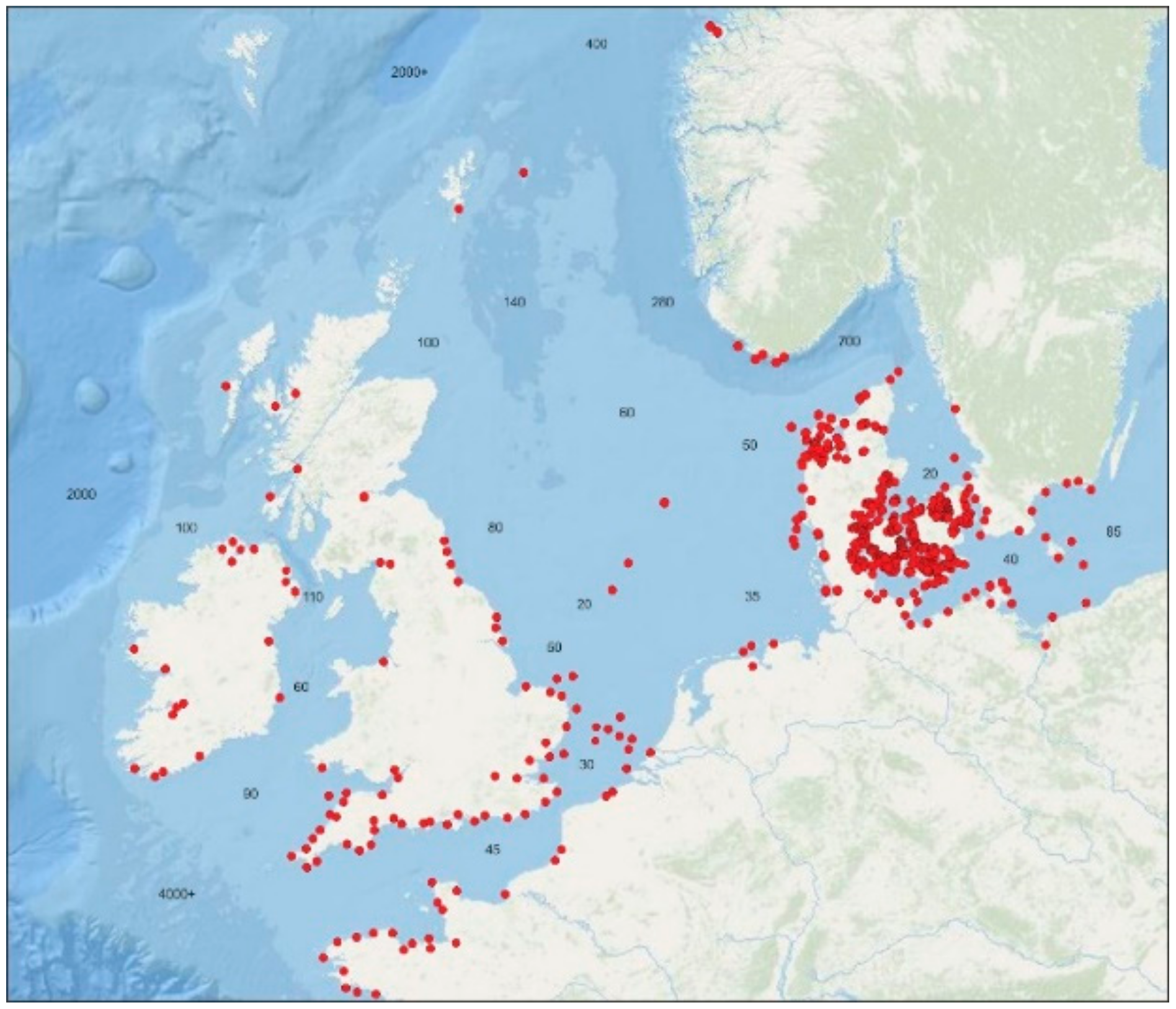
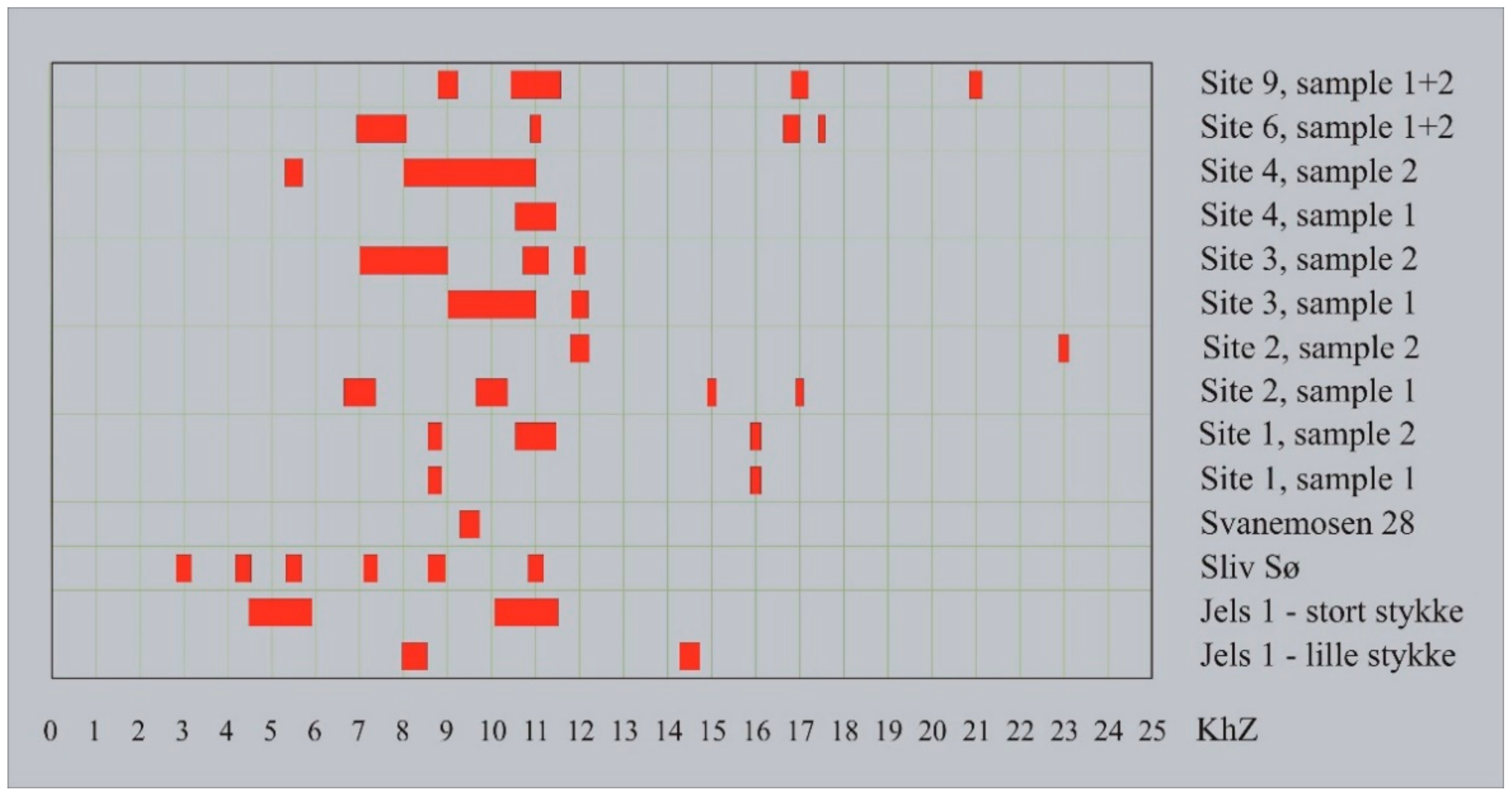
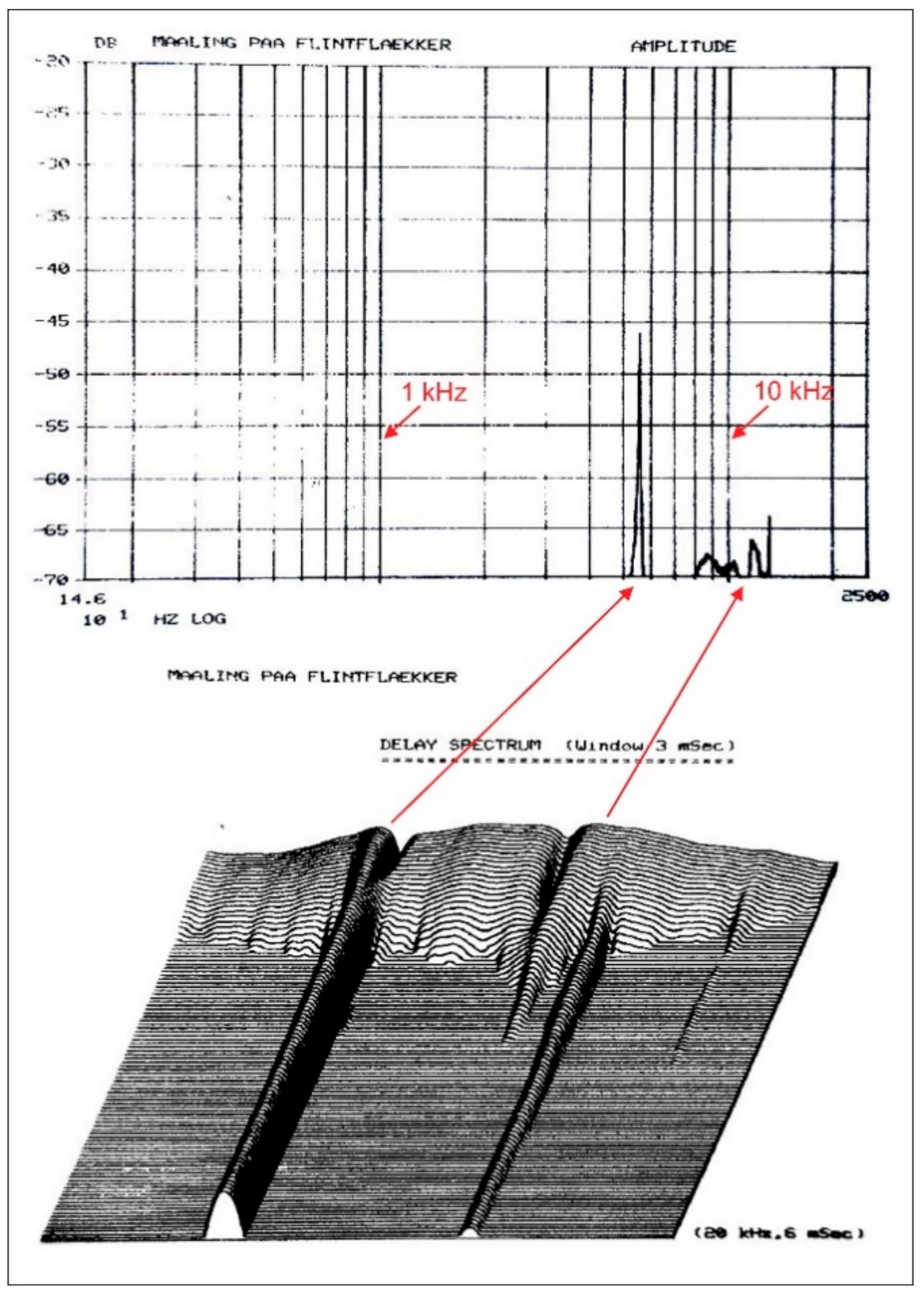

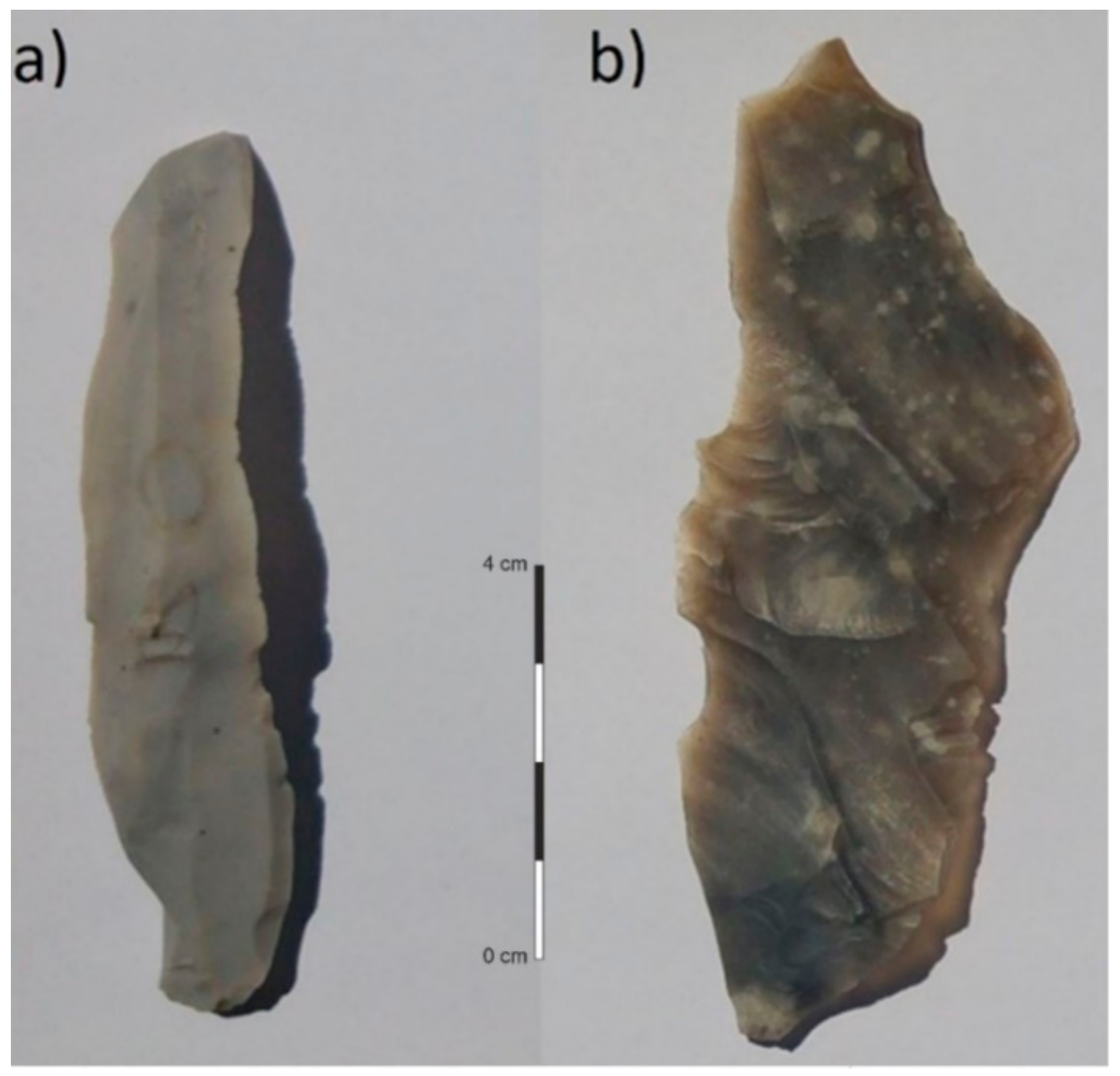
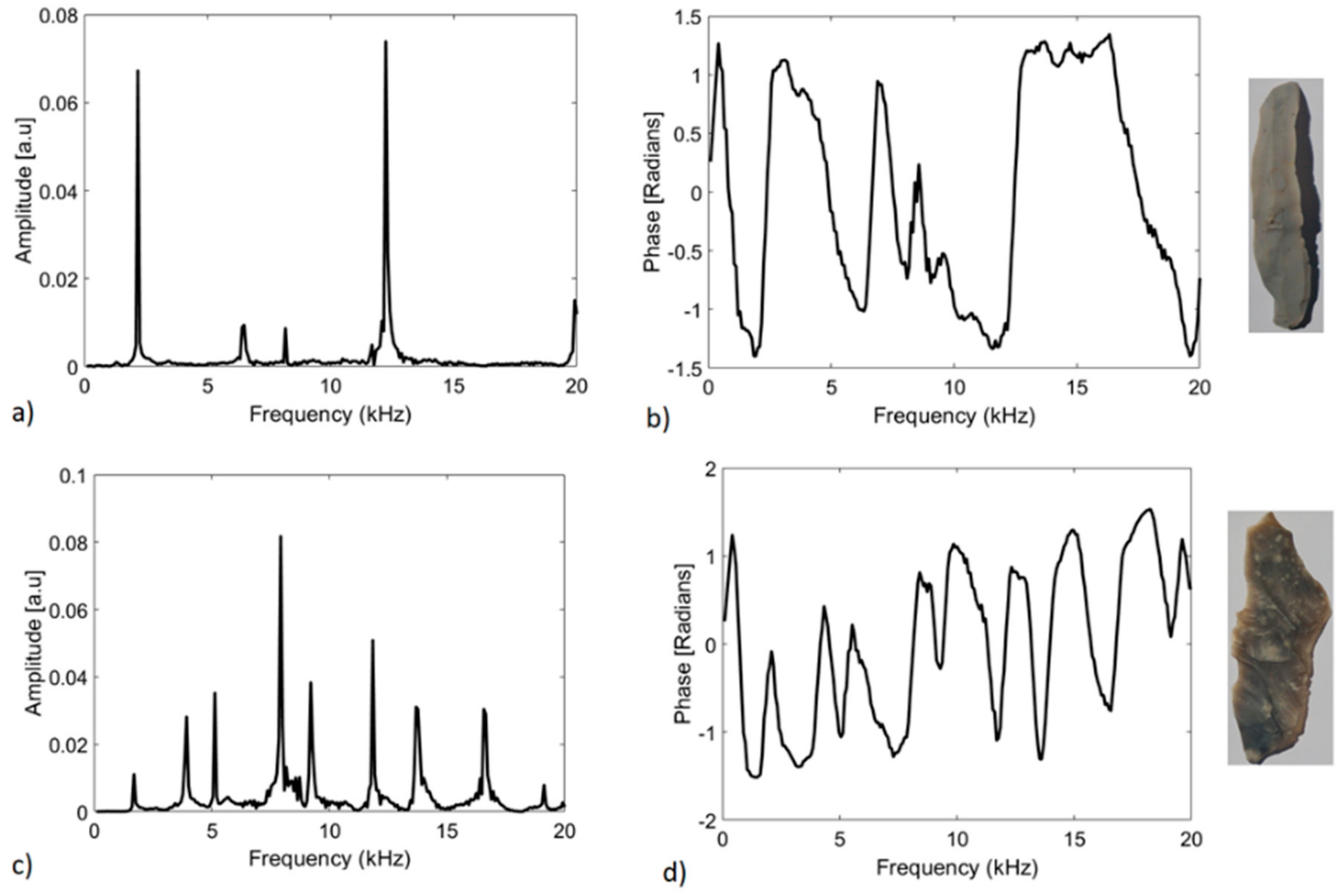
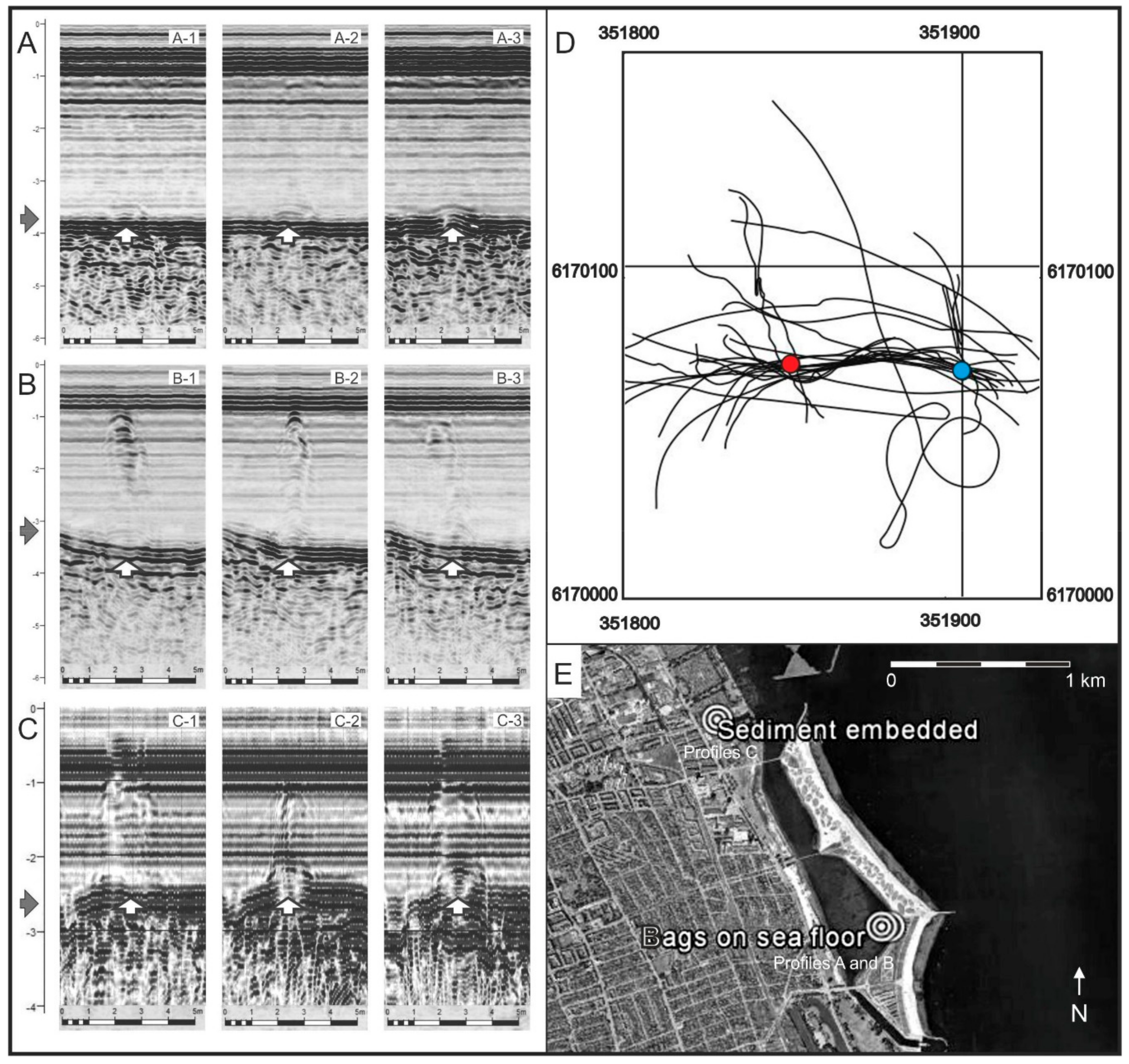
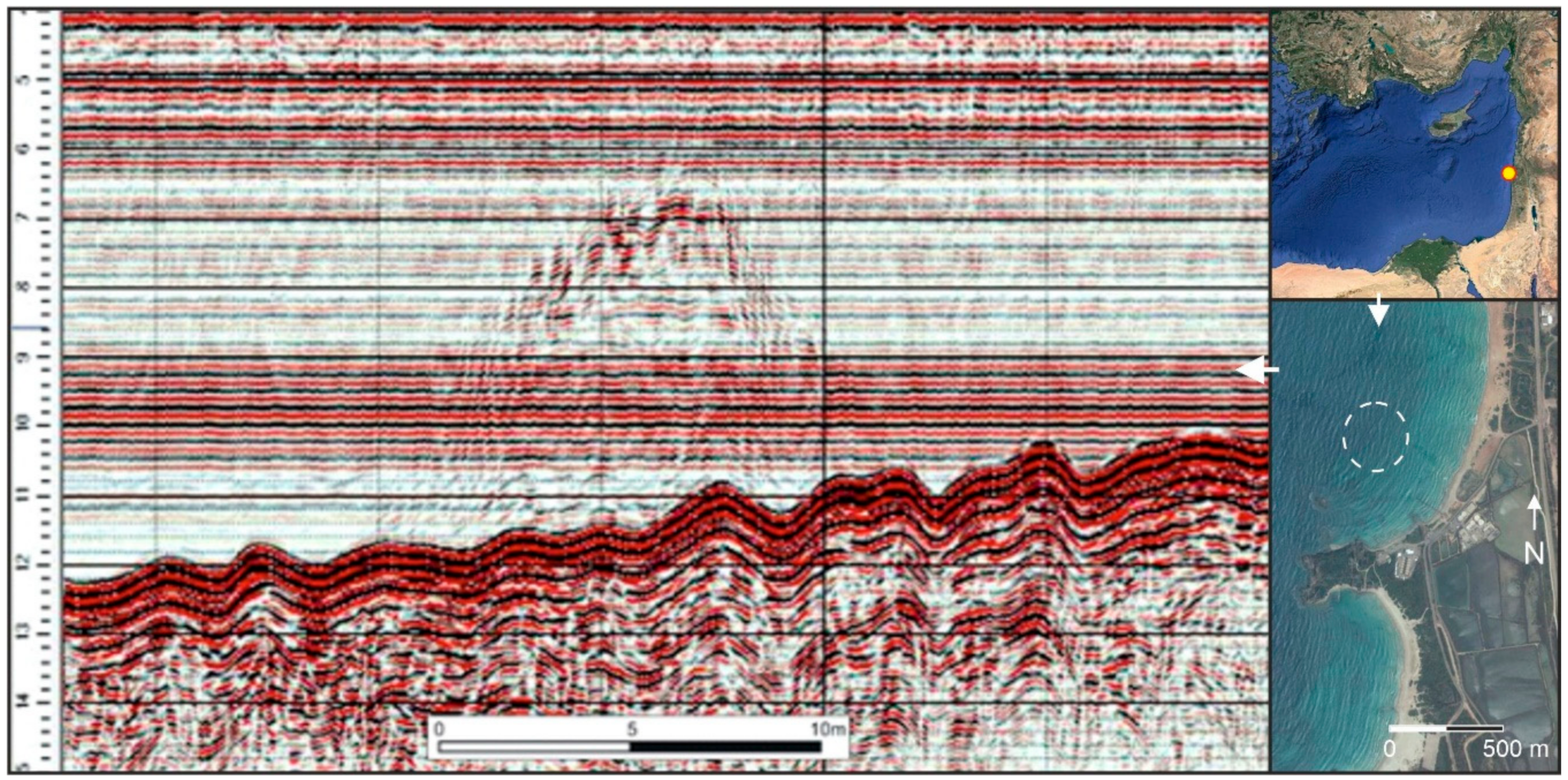
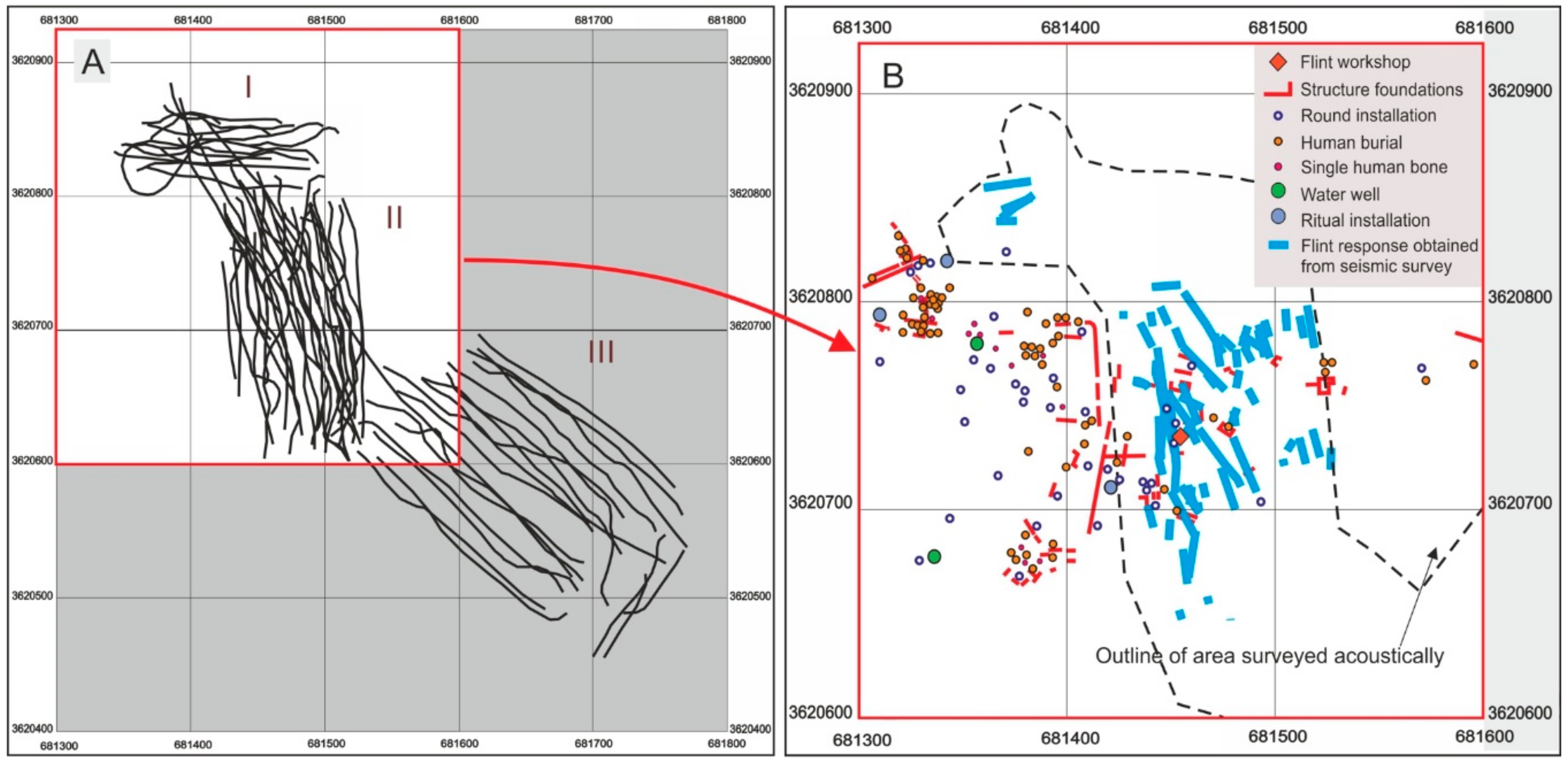
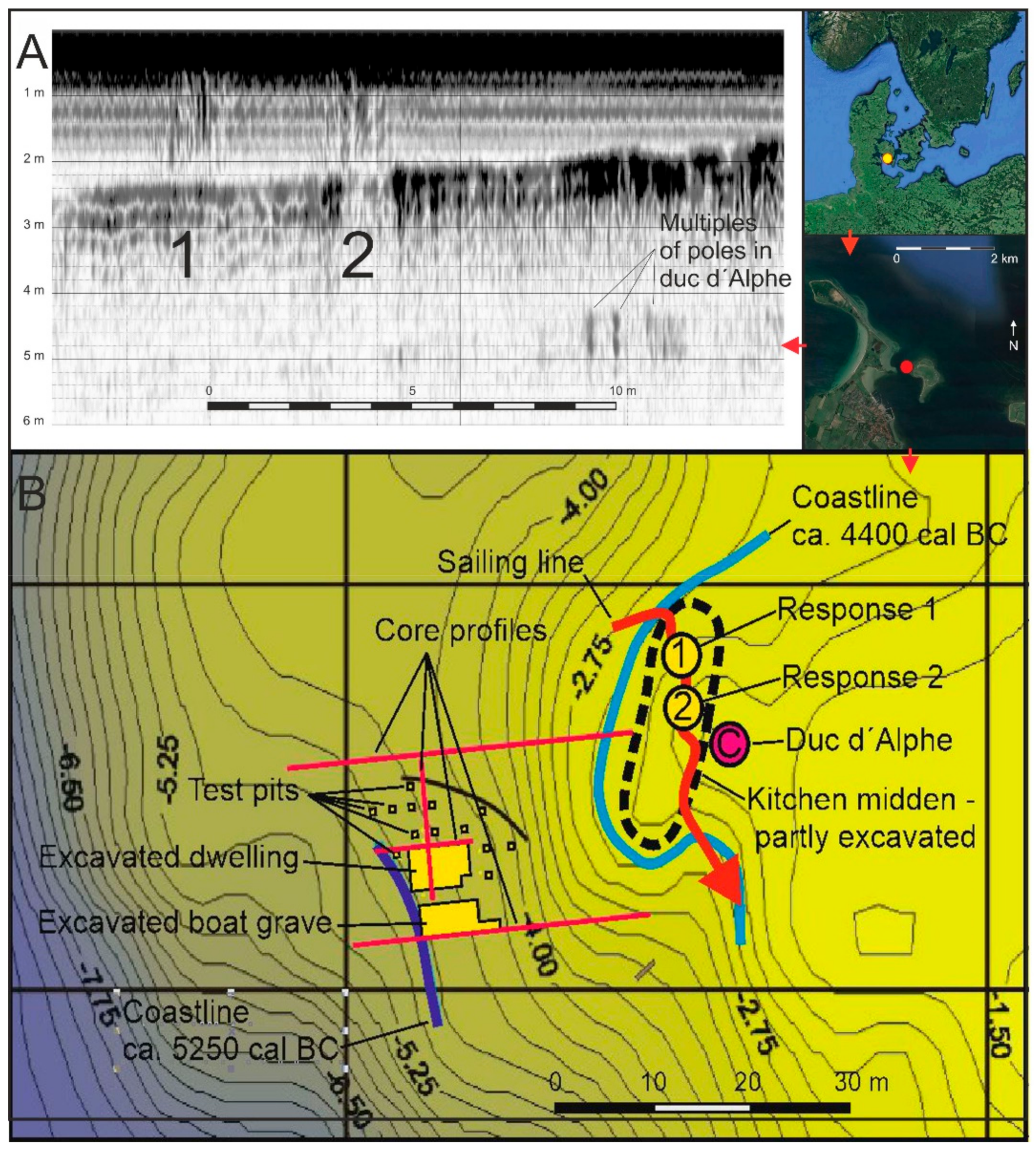
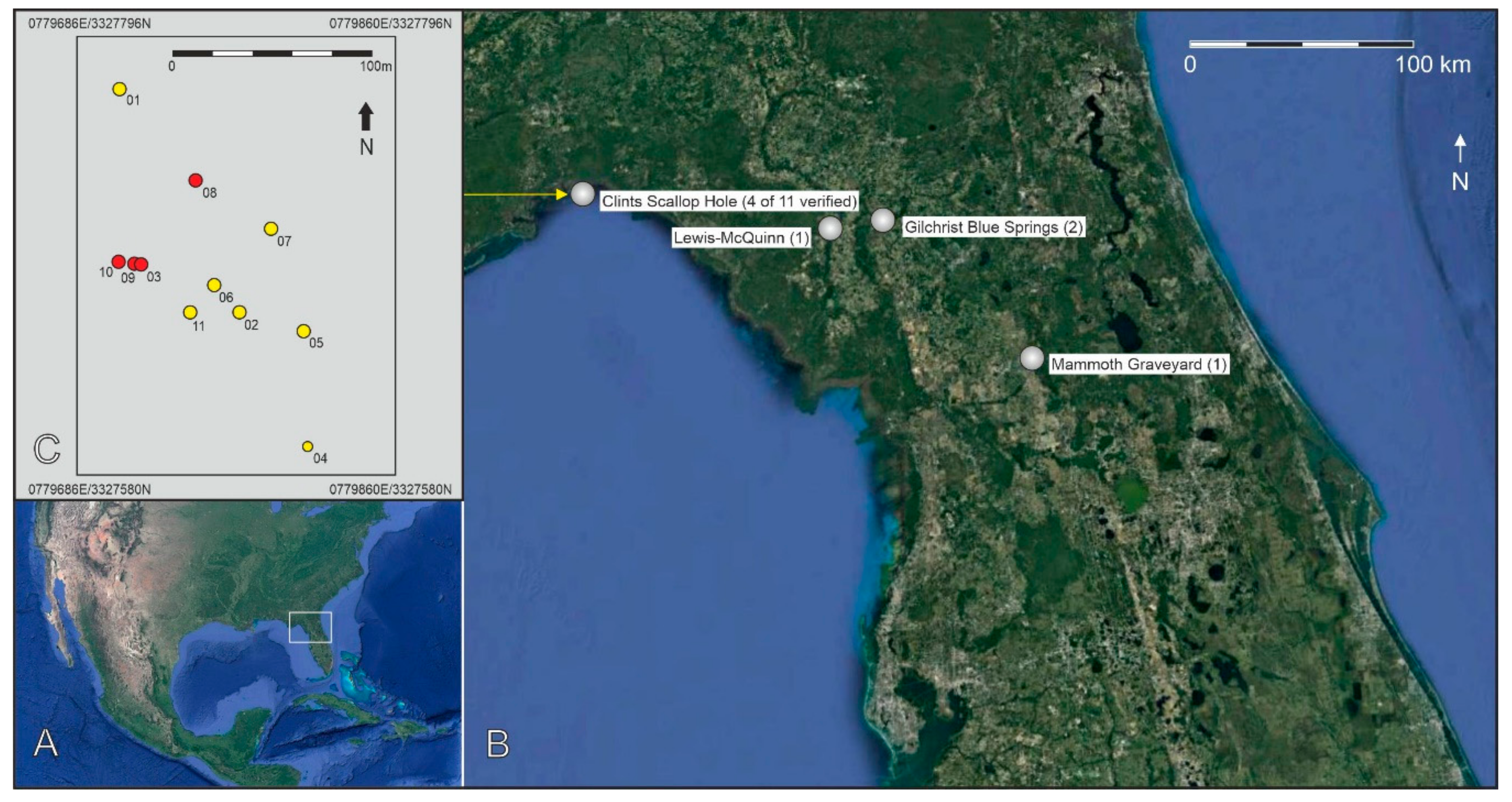
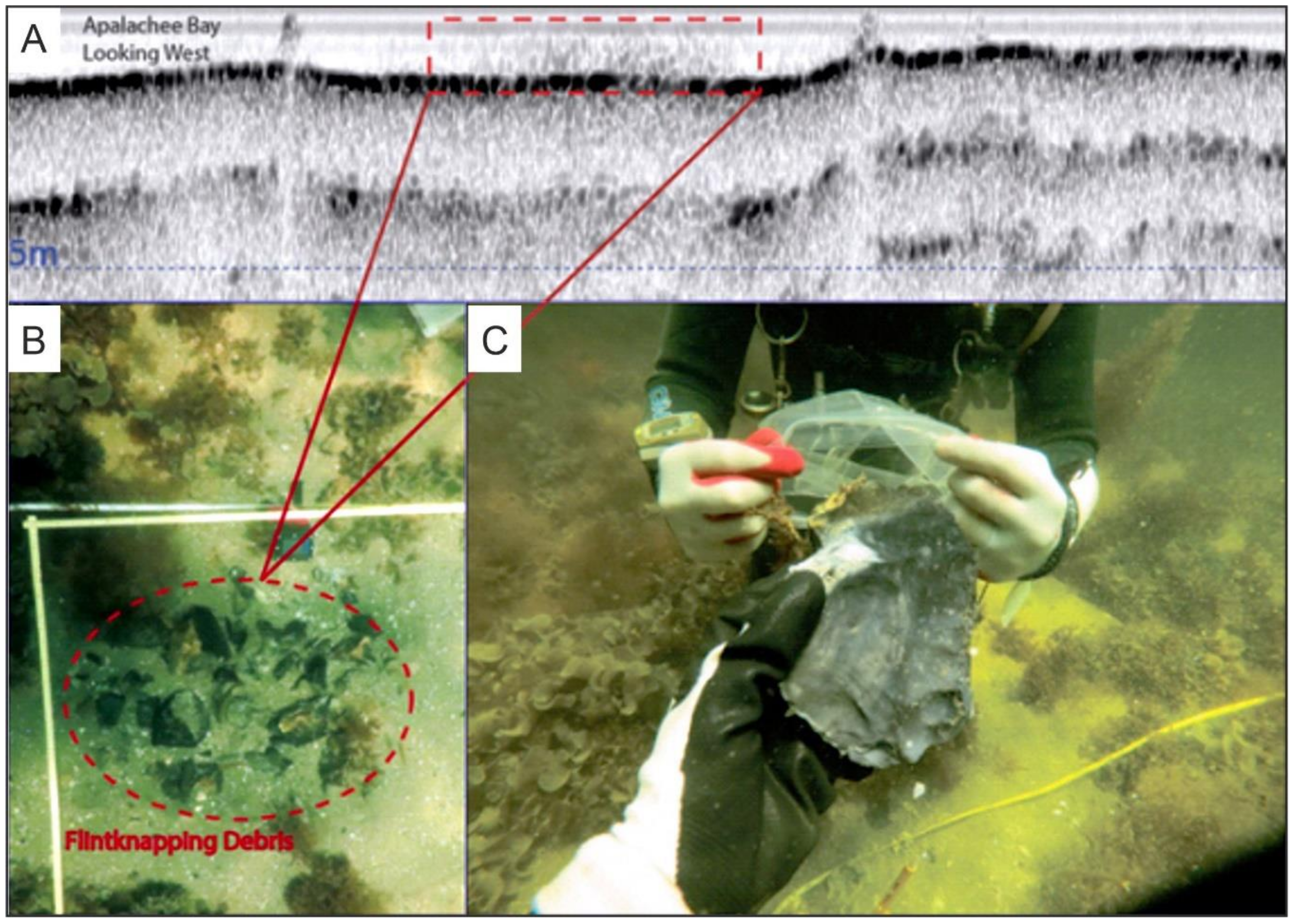
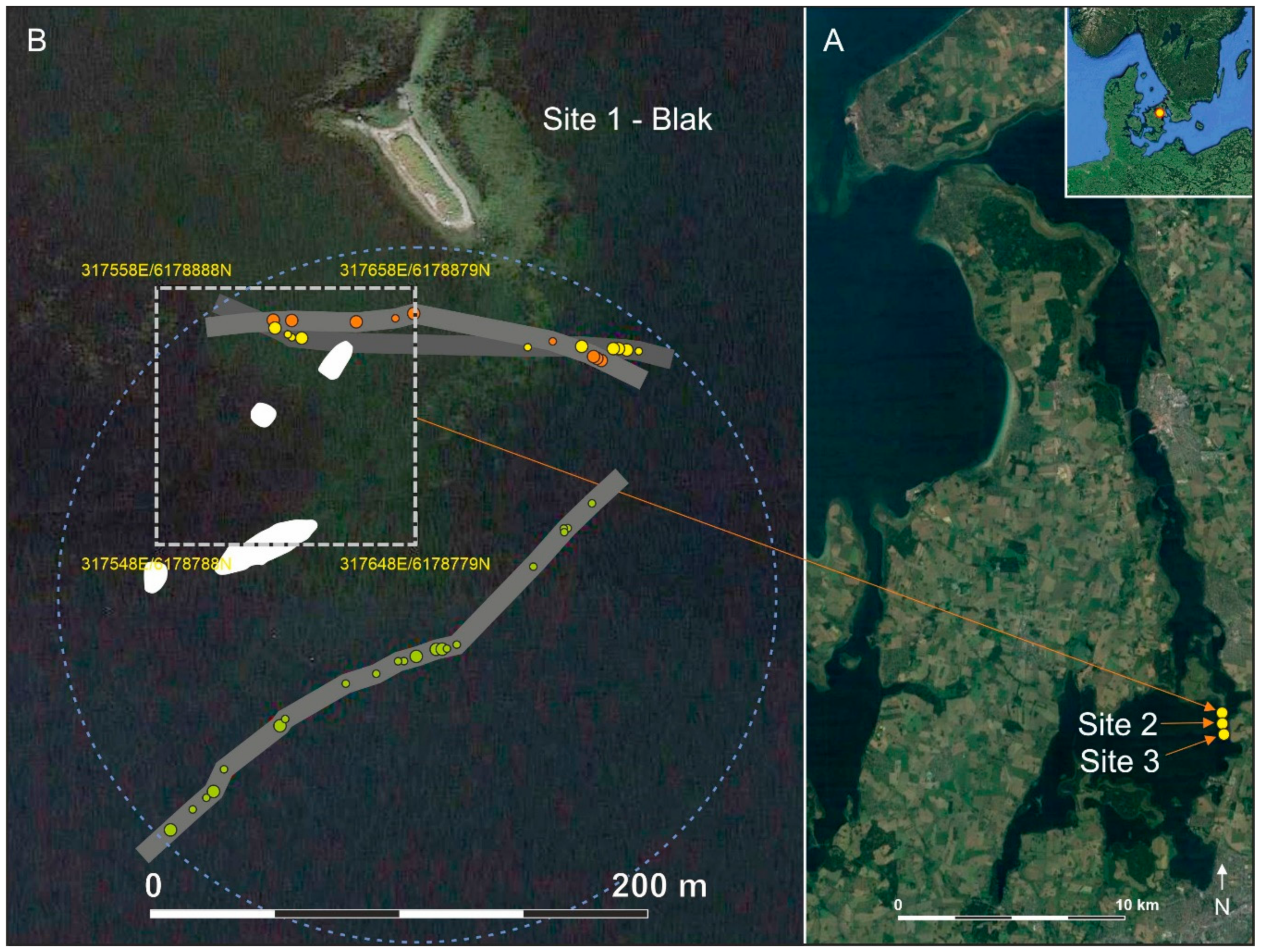
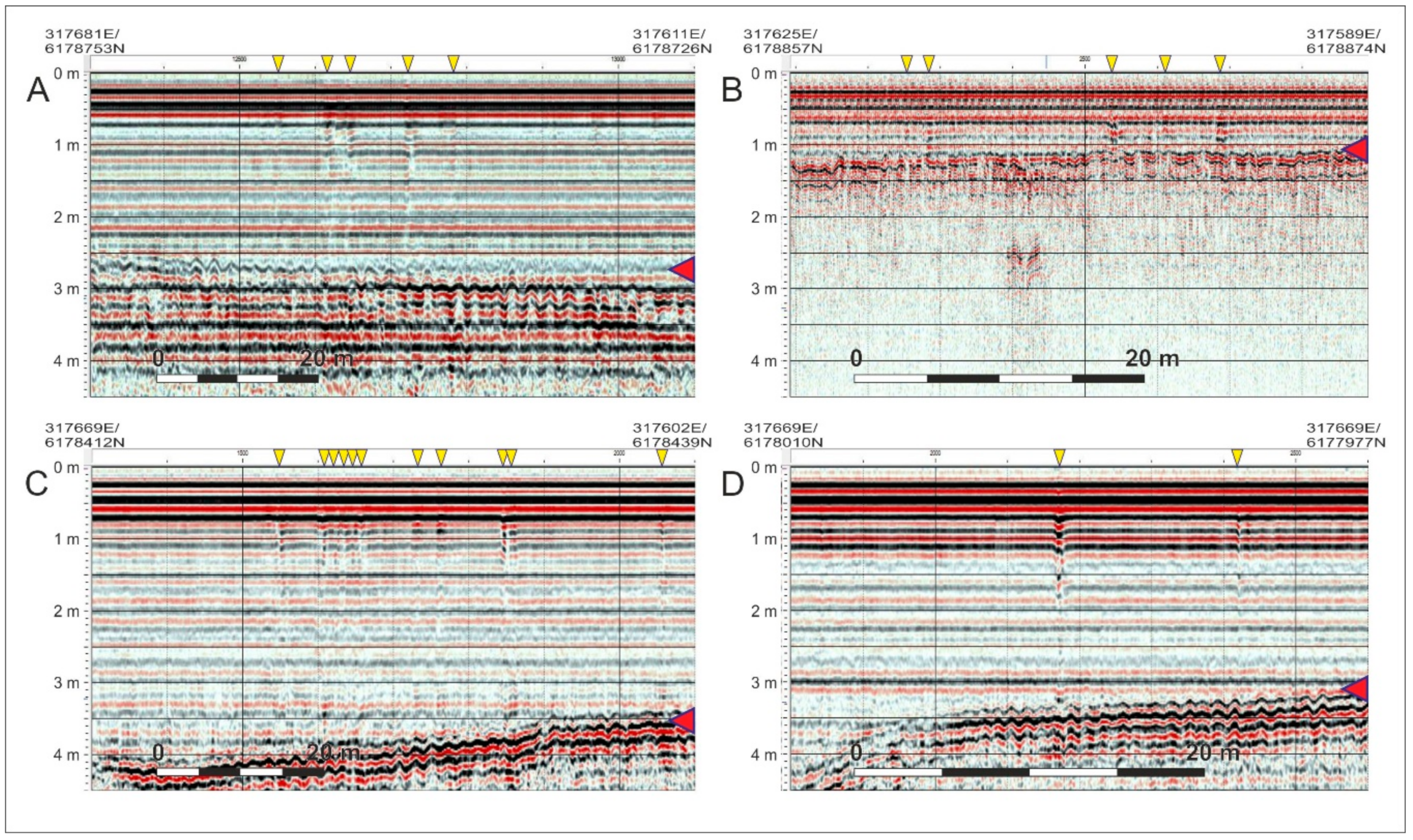
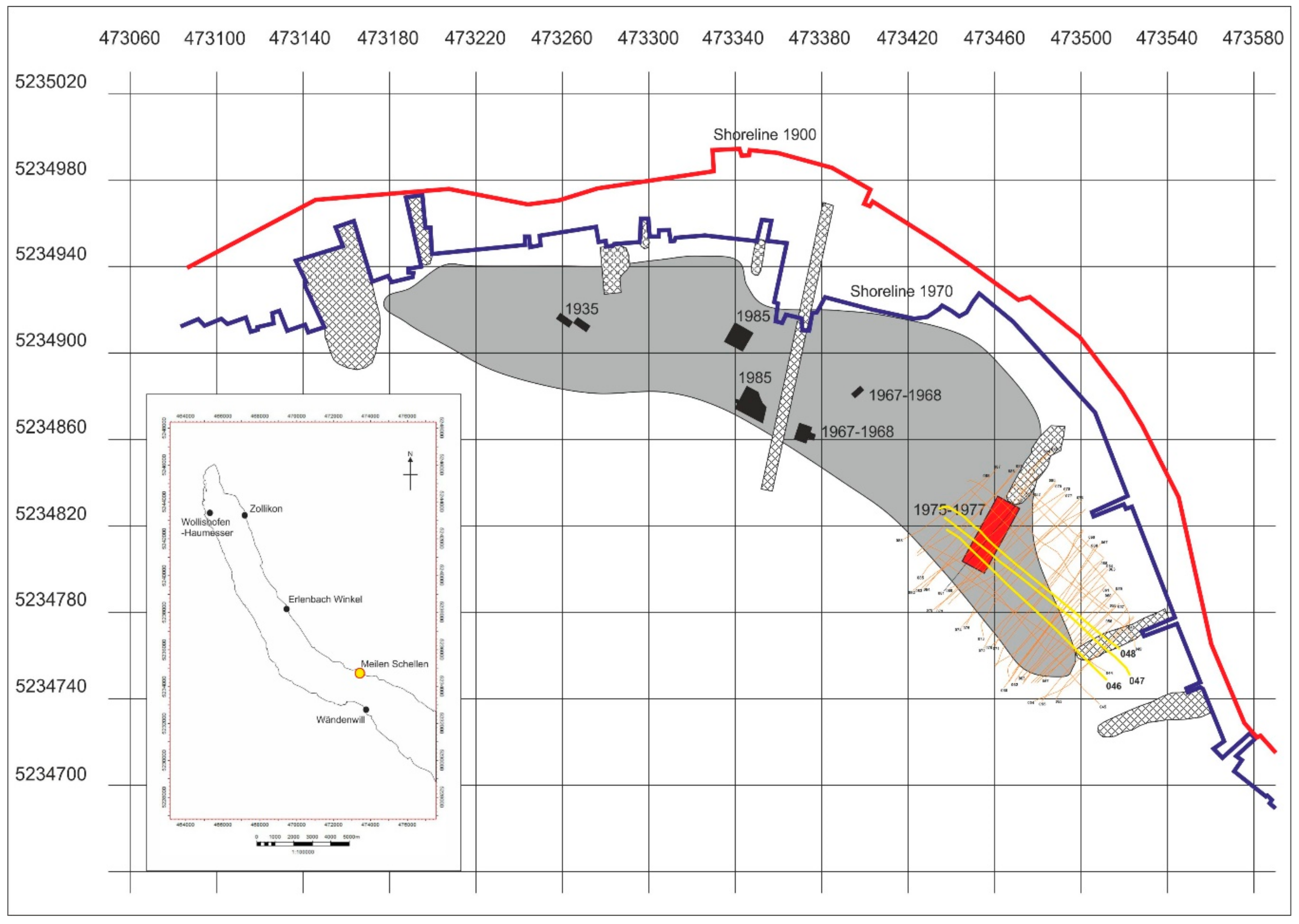
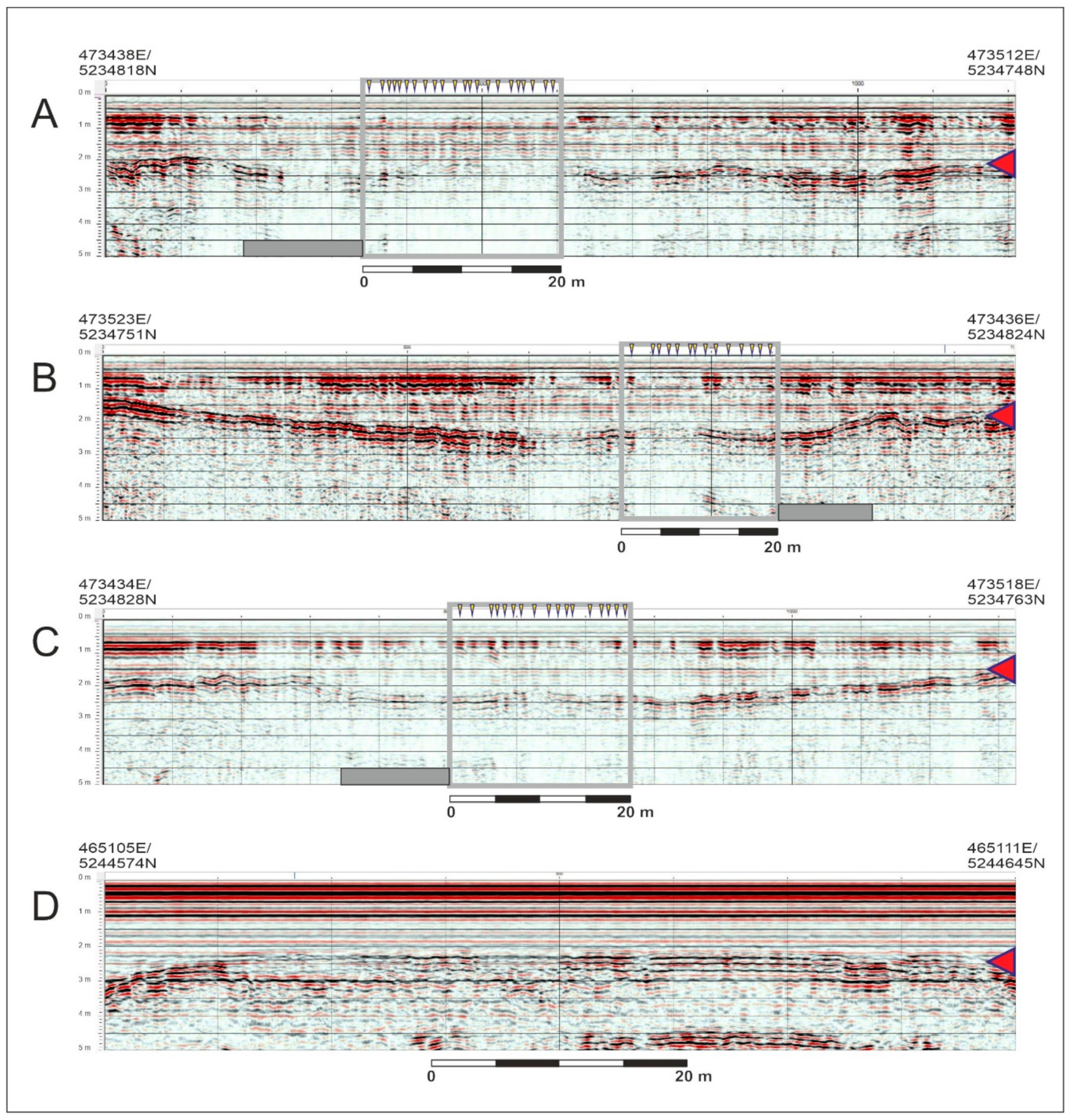
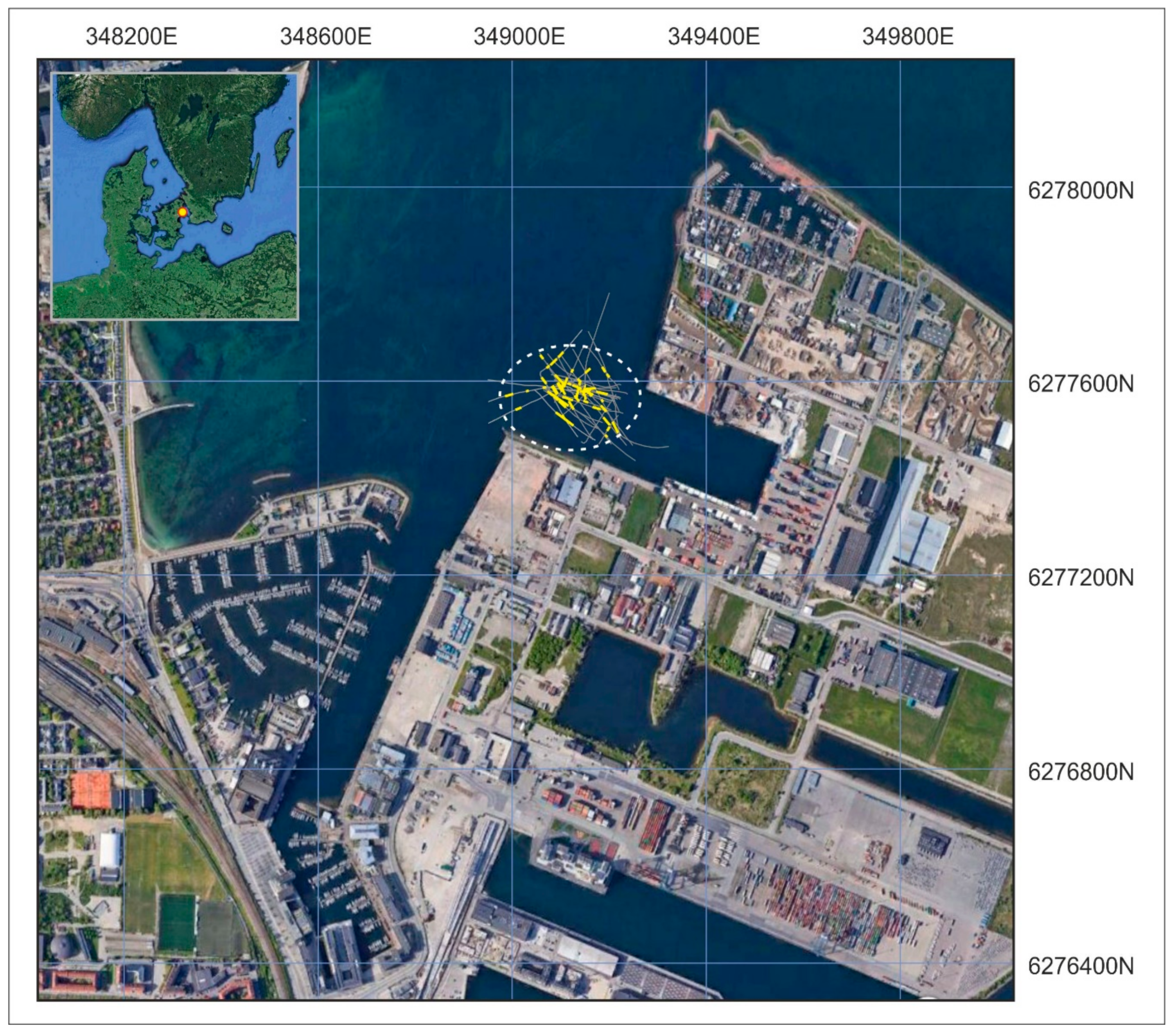
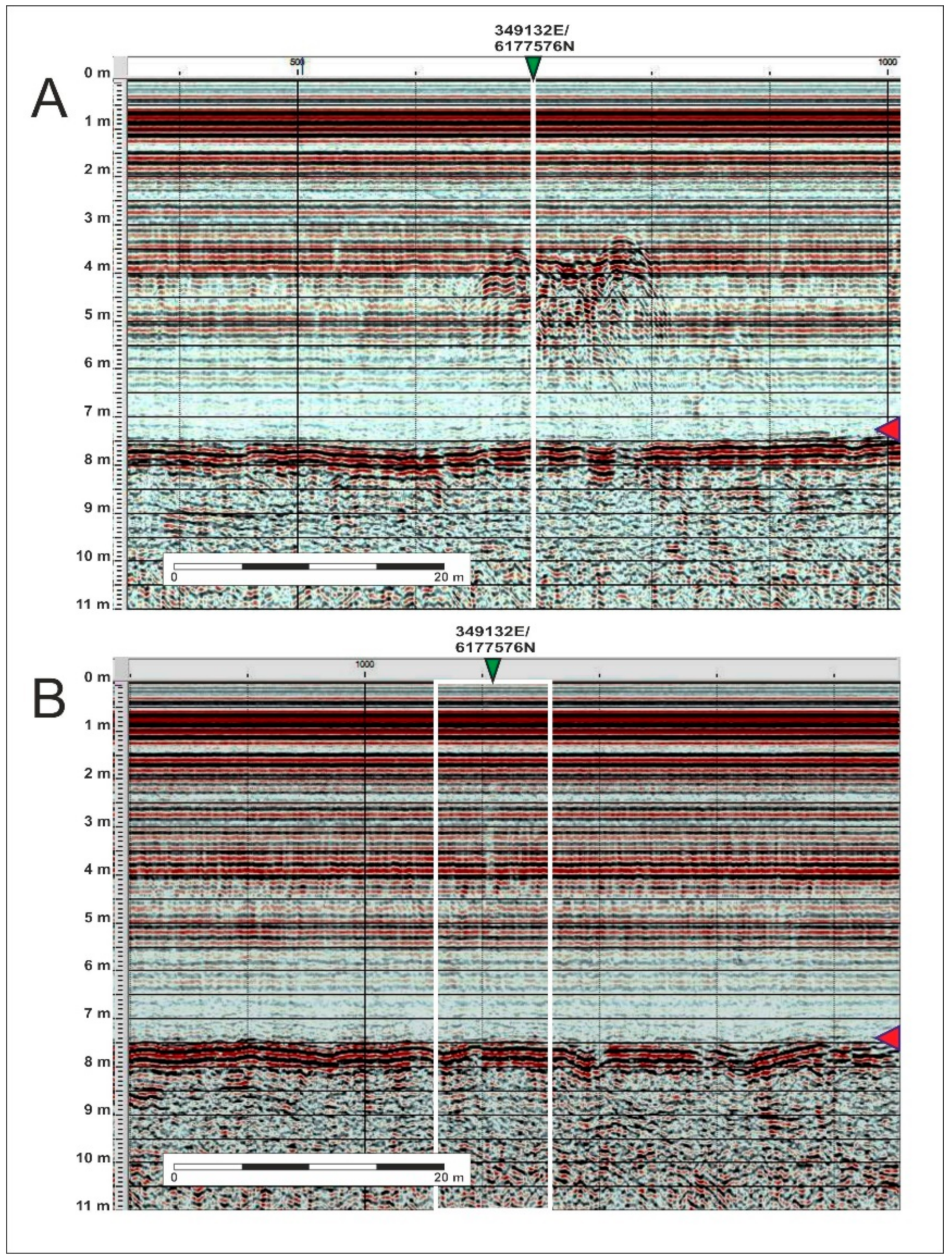
| Length (mm) | Width (mm) | Thickness (mm) | Curved? | |
|---|---|---|---|---|
| Sample 1 | 86.92 | 18.91 | 4.66 | Yes |
| Sample 2 | 101.91 | 33.52 | 3.66 | No |
| Site where HALD Has Been Applied as of Writing | Verification of Lithic Response Features | Lithic Burial Depth and Substrate | Site Type | Lithic Type | Water Depth m | Response from already Known Sites | Newly Observed Responses, Diver-Verified | Unverified Newly Observed Responses |
|---|---|---|---|---|---|---|---|---|
| Atlit Yam, Israel | Artifacts identified at multiple haystack locations by excavation. | Up to 2 m of medium sand. | Settlement, −8000 calBP. High artifact density. | Flint | 10–12 | 1 | ||
| Mollegabet, Denmark | Artifacts identified at multiple haystack locations by excavation. | Embedded in shell midden under cover of drift sand. | Settlement, −7000 calBP. High artifact density. | Flint | 2 | 1 | ||
| Lewis McQuinn, Florida, USA | Artifacts identified at multiple haystack locations by excavation. | Exposed to buried by up to 15 cm of medium sands and silt. | Short-term campsite; >−4000 calBP. Low artifact density. | Chert | 2 | 1 | ||
| Clints Scallop Hole, Florida USA | Artifacts identified at four haystack locations by divers. | Exposed to buried by up to 15 cm of medium sands. | Quarry, >−3500 calBP. High artifact density. | Chert | 2–3 | 4 | ||
| Mammoth Graveyard, Florida, USA | Artifacts identified at a haystack location by divers. | Buried by −10 cm of modern shell hash. | Lithic scatter; age unknown. Low artifact density. | Chert | 6 | 1 | ||
| Gilchrist Blue Spring, Florida, USA | Artifacts identified at two haystack locations by snorkelers. | Exposed. | Lithic scatter; age unknown. Low artifact density. | Chert | 2 | 1 | 2 | |
| Roskilde Fjord, Denmark | Acoustic response features identified at the well-known and previously partly excavated Blak Site (401257-3) | Varying from exposed settlement surface to ‘waste layer’ material embedded up to 1 m in marine gyttja. | Settlement; 8400–8100 calBP. High artifact density. | Flint | 1–4 | 1 | ||
| Roskilde Fjord, Denmark | Acoustic response features identified at two known sites 401257-56 and 401257-57 | Surface exposed concentrations of knapped lithics. | Settlements; Stone Age. | Flint | 3 | 2 | ||
| Meilen Schellen, Switzerland | Acoustic response features identified at the location of previously partly excavated site. | Embedded in up to −1.2 m of cultural deposits. | Pile dwellings; −5500 calBP. Low artifact density. | Local radiolarite, quartzite, a variety of more exotic materials | 2 | 1 | ||
| Svanemollen Harbour, Denmark | A 8 × 120 m large concentration of unverified acoustic response features identified in a recognizable submerged landscape. | Embedded in 1 m of silt. | According to the depth it must be Early Mesolithic or earlier. | Unknown | 7 | 1 | ||
| Eriksberg, Sweden | A large number of unverified acoustic response features identified in an area where no submerged sites have earlier been recorded. | Embedded in 0–2 m of silt. | According to the depth it must be Early Mesolithic or earlier. | Unknown | 1–6 | Many | ||
| Sum | 7 | 8 | Many |
Publisher’s Note: MDPI stays neutral with regard to jurisdictional claims in published maps and institutional affiliations. |
© 2021 by the authors. Licensee MDPI, Basel, Switzerland. This article is an open access article distributed under the terms and conditions of the Creative Commons Attribution (CC BY) license (http://creativecommons.org/licenses/by/4.0/).
Share and Cite
Grøn, O.; Boldreel, L.O.; Smith, M.F.; Joy, S.; Tayong Boumda, R.; Mäder, A.; Bleicher, N.; Madsen, B.; Cvikel, D.; Nilsson, B.; et al. Acoustic Mapping of Submerged Stone Age Sites—A HALD Approach. Remote Sens. 2021, 13, 445. https://doi.org/10.3390/rs13030445
Grøn O, Boldreel LO, Smith MF, Joy S, Tayong Boumda R, Mäder A, Bleicher N, Madsen B, Cvikel D, Nilsson B, et al. Acoustic Mapping of Submerged Stone Age Sites—A HALD Approach. Remote Sensing. 2021; 13(3):445. https://doi.org/10.3390/rs13030445
Chicago/Turabian StyleGrøn, Ole, Lars Ole Boldreel, Morgan F. Smith, Shawn Joy, Rostand Tayong Boumda, Andreas Mäder, Niels Bleicher, Bo Madsen, Deborah Cvikel, Björn Nilsson, and et al. 2021. "Acoustic Mapping of Submerged Stone Age Sites—A HALD Approach" Remote Sensing 13, no. 3: 445. https://doi.org/10.3390/rs13030445
APA StyleGrøn, O., Boldreel, L. O., Smith, M. F., Joy, S., Tayong Boumda, R., Mäder, A., Bleicher, N., Madsen, B., Cvikel, D., Nilsson, B., Sjöström, A., Galili, E., Nørmark, E., Hu, C., Ren, Q., Blondel, P., Gao, X., Stråkendal, P., & Dell’Anno, A. (2021). Acoustic Mapping of Submerged Stone Age Sites—A HALD Approach. Remote Sensing, 13(3), 445. https://doi.org/10.3390/rs13030445








